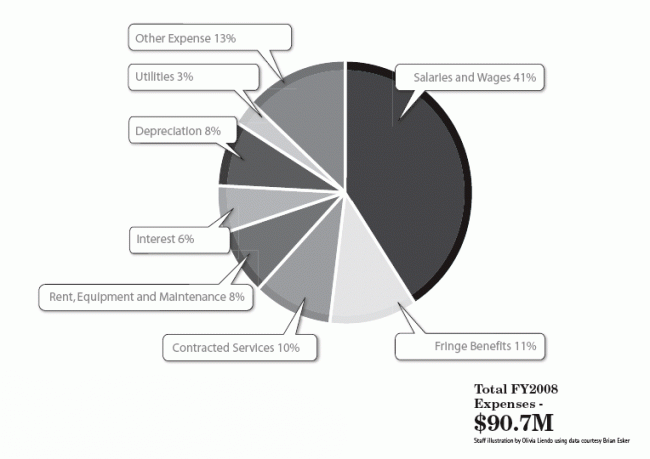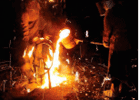Recapping the major points of the Town Hall meeting
On April 13, during a rainy Monday afternoon, the Columbus Auditorium was half-filled with curious SAIC students, and a handful of faculty, attending a Town Hall meeting organized by the Student Association. The meeting included presentations by President Wellington “Duke” Reiter, VP of Finance and Administration Brian Esker and VP of Enrollment Management Rose Milkowski.
Duke presented ideas from his “Fast Forwarding Project,” which he had shared with the faculty in early fall 2008. In terms of the Student Experience, he recognized that SAIC is a tuition-driven school that has nearly doubled its undergraduate population in the past decade, and needs to create a stronger sense of community.
There is a big push for development right now, but in this dreary economic landscape precise fundraising strategies need to be employed aimed at specific projects. Some of these highly speculative plans include sharing the MacLean Ballroom space with a library, and building a ground-level or second-floor student center, possibly in the Sullivan Center or on the corner of Wabash Ave.
Hopefully, any new construction will be more than just another place to drink iced tea, and will include plenty of space for students to work on projects and exchange ideas. Paul Coffey, Associate Dean of Academic Administration, is encouraging students to make their own proposals for what they think a student center should include. Coffey told F Newsmagazine that his door is always open and that he hopes to make the deans’ offices in the Sharp Building more accessible to students.
As he did in the faculty-only meeting on March 19, Esker was called on to deconstruct how the current economic recession is impacting the School. After four years of solid growth we are better off than most. This is in part due to a five-year strategic planning committee formed in 2002 to study the relationship between the endowment and debt (then at $187 million because of excess building purchases and renovation).
The School’s debt is currently at $131 million. However, while SAIC’s endowment fell by 24%—from an all-time high of $192 million in 2007 to $141 million—other universities, like Harvard, saw their endowments drop by as much as 30%. Esker explained what could seem like an esoteric endowment formula to non-CFOs: a financial equation which involves spending approximately 5% of the endowment’s assets each year while reinvesting the remaining funds to gain interest for the future. An endowment is built on gifts the school receives, and this system ensures that the principal investment continues to grow over the years.
Rose Milkowski, who oversees enrollment and financial aid, reminded all students to file the fafsa and to speak with their financial aid advisor regarding earning changes or other extenuating circumstances for possible adjustment to their 2009-10 financial aid package, as well as the most up-to-date information on loans. Several students asked for more funding, as well as the opportunity to apply for merit scholarships after matriculation. They also asked about increasing opportunities for transfer and international students.
COURSE CUTS
At the Town Hall meeting, Interim Dean of Faculty Lisa Wainwright assured students that the academic deans and department chairs maintain their commitment to small classes and a pluralistic, progressive education. She said that typically about fifty classes are cut each semester due to low-enrollment, but that 140 will be cut preemptively for the 2009-10 school year from the usual 2,100-course offering. Wainwright and Coffey have been working closely with department chairs to isolate each area’s core curriculum, attempting to cut redundant sections of a class or offer a particular class fewer times a year rather than lopping off whole programs.
Of the cancelled classes, the breakdown is intended to be roughly proportional to department size: AIADO (4); Arts Administration (4); Art History (9); Art and Tech (5); Ceramics (1); Fashion (2); FVNM (5); Historic Preservation (1); Liberal Arts (8); Painting and Drawing (12); Performance (1); Photography (4); Sculpture (3); Visual Communication (8); VCS (1); Writing (1). It is unclear whether student evaluations were taken into account during this process.
Additionally, 531 seats are gained by increasing caps by two students in 50% of classes, and by as many as six in others. Additional curricular changes in the future may include a decrease in credits required for the BFA degree from 132 to 120-126 credits, in order to relieve the strenuousness of a six-class semester. However, there will be no changes to the requirements in the next academic year.
PART-TIME FACULTY
Wainwright shared that the School has “in fact hired a few more faculty,” but, while she acknowledged “some discontent” among instructor-level and adjunct part-time faculty who lost classes, she has received only two emails on the subject from the School’s 300-plus instructors, 60 adjunct assistant professors, 68 adjunct associate professors, 32 adjunct professors and 150 full-time faculty. The administration has also said that efforts were made to reduce teachers’ classes rather than to put anyone completely out of work.
After three years as an instructor (which pays about $31.50/hour for studio class contact hours), an instructor may apply for a position as an adjunct assistant professor. This promotion comes with an eight-percent raise and access to benefits, and is the first wrung on the competitive, crowded climb to adjunct professor status (which entitles the faculty member to a minimum per course rate of $7000). Opportunities to move from instructor to adjunct are, however, extremely limited, with the promotion process being painfully competitive.
Wainwright—who is referred to as “the Lioness” for protecting part-timers’ rights—acknowledged the difficulty with this multi-tiered labor force. The current picture of the school is at odds with section 1A of the Faculty Handbook, which states: “It shall be school policy to see that at least two-thirds of the full-time equivalent faculty positions in its college level studio programs are held by full-time faculty members.”
As the School has grown dramatically in the past ten years and several new departments and graduate programs have been incorporated, the full- to part-time ratio has been thrown off. Wainwright, as well as other administrators, has said that SAIC should be built on more full-timers with a small, flexible pool of spots for instructors to teach temporary, “one-off” classes.
The course cuts are hitting new hires and instructors hardest, many of whom are already struggling with the base wage of $3400/class (last year the part-time concerns committee succeeded in getting the base instructor wage raised to this sum). And, as one instructor told F Newsmagazine, the increased caps and course sizes amount to a pay-cut for faculty across the board.
If it takes forty-five minutes to grade each student’s essay, an increase of five students means nearly four more hours of work per assignment that the teacher is not getting paid for. The difference between a twenty-five and thirty-student class is also huge when considering the needs of the shyer, quieter students and the syllabus concessions needed to adjust for the extra students.
Current goals of the newly formed SAIC chapter of the American Association of University Professors (AAUP) include framing the dialogue of the ongoing debate, setting standards for part- and full-time faculty course load and making SAIC a fair-wage institution.
NEON & HOLOGRAPHY UPDATE
Representatives from the student protest group the Neon Underpanties and the Facebook group Save The Holography & Neon Labs attended the Town Hall meeting. Wainwright confirmed suspicions that in the wake of the January flood in the basement of the Michigan Building, the Neon and Holography labs will remain closed for the fall 2009 semester, but that the faculty is “in discussions about how to integrate these areas into the larger Art and Tech plan and possibly a Light department.”
The computer-based Neon Animation class will be offered in the fall (and is filled to capacity), while the more hands-on Neon Techniques has been cancelled. Both Beginning and Advanced Holography have been removed from the course catalogue, though both areas remain on the Art and Tech department’s website.
Possible alternatives being discussed are rebuilding smaller Neon and Holography labs that would open onto a larger, shared Art and Tech lab, getting a glass shop on retainer to do the glass-bending work for the Neon students, or perhaps holding the classes off-campus in a faculty-affiliated studio. The latter is by far the most popular option with the students I spoke to, since this could be arranged relatively easily with departmental and administrative approval.
Second-year students Adriene Lilly, Emily Boksenbaum and Alex Simes founded the Facebook group last month to address rumors and organize student efforts to save these areas of the curriculum. Save The Holography & Neon Labs, which has upwards of 189 members, is working to find out the exact cost of rebuilding the slightly damaged labs in order to raise money from alums working in the field if necessary, and to keep the labs alive by demanding progress reports and substantive answers from the administration such as where, when and how the labs will reopen.
Concerned parents have started writing letters to the administration in an effort to save these beloved areas of their kid’s costly educations. At 10pm on April 16 many members of the group took action by emailing President Reiter with individual arguments for saving the curriculum and rebuilding the labs.
STUDENT ACTIVISM
There is an air of activism floating around “campus” this spring, and a handful of students at the Town Hall meeting expressed their desires for a more active student government. The Student Association (formerly known as the Student Government) is comprised of a third-year student and three graduating seniors, toiling away in room 1302A of the MacLean Center. They are responsible mainly for funding and, according to their recently implemented monthly newsletter (it can be found under the Campus Activities section of the Portal), for co-sponsoring events such as the Welcome Back to School Party, All-School Barbecues, Holiday and Spring Art Sales, the First Thursdays events and the implementation of the School’s ExTV station.
Following several years of apathy and low voter turnout, these paid positions are now appointed based on previous accomplishments in the school (eliminating underclassmen from the running). The Student Association 2009-10 applications and April 10 deadline were not widely publicized, though their mission on the School website states that the Student Association “represents all students enrolled at the School, providing students with a voice in School decisions.”
During this tumultuous time, there are currently several informal student groups looking at communication at SAIC and exploring how to form a student government responsible for substantive issues and held accountable to their electorate.
Correction Appended: The “High Noon?” article from the April 2009 issue stated that 52% of the 2008 budget was used for faculty salaries. The number should have represented total salaries.









